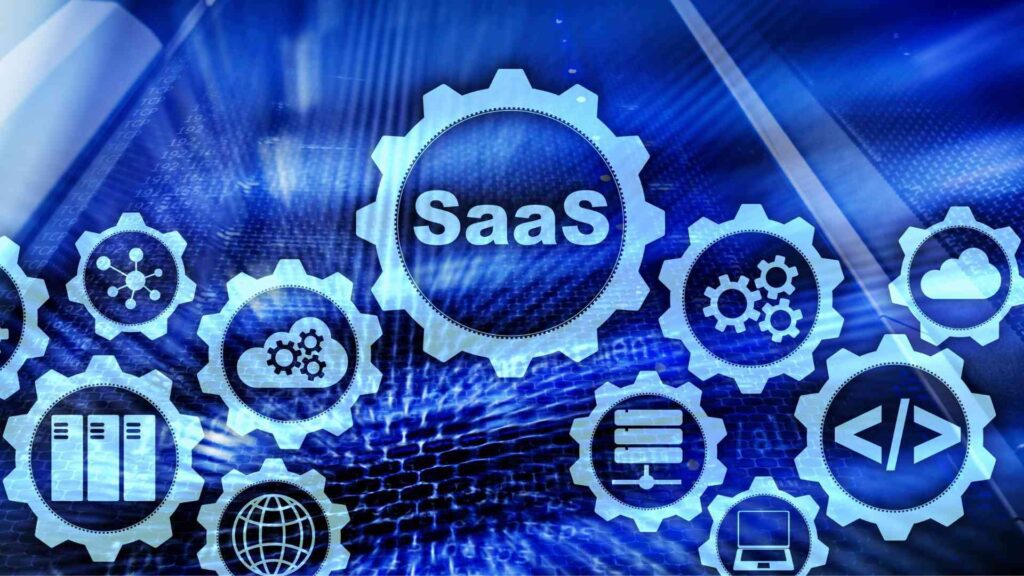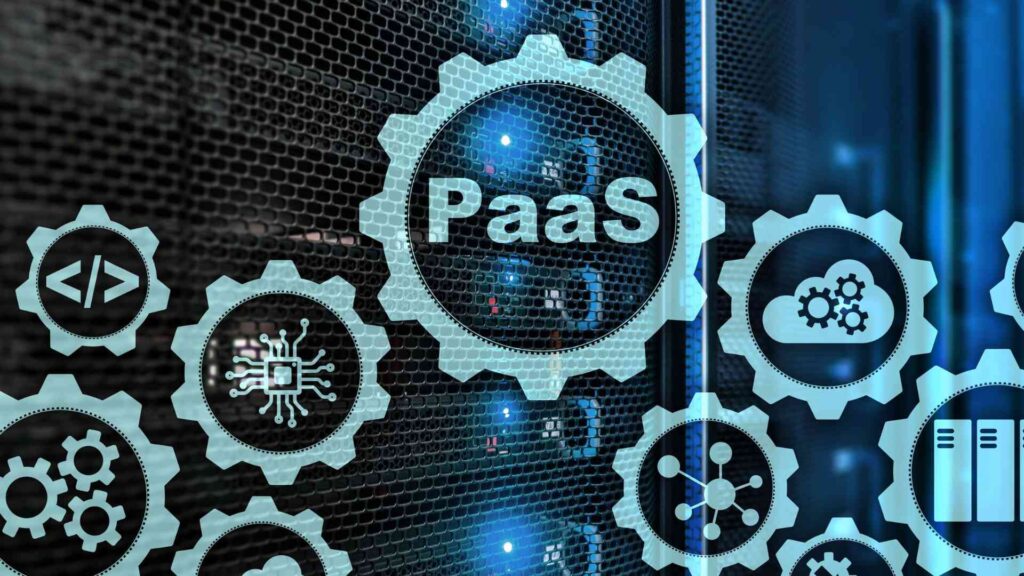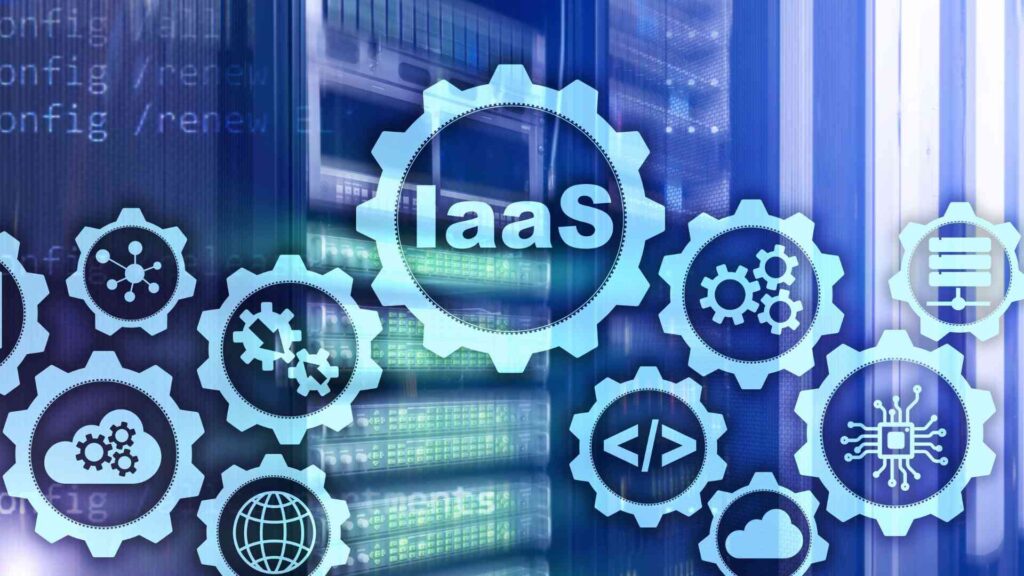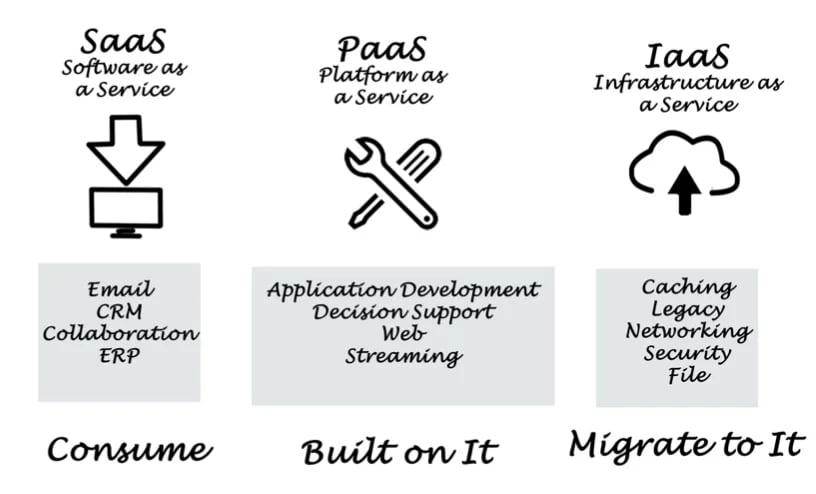With the rise of digital transformation, cloud computing has become a vital component in the world of technology. It offers scalable, flexible, and cost-effective solutions for businesses of all sizes. However, navigating through the different types of cloud services can be complex. Understanding the differences between SaaS, PaaS, and IaaS is crucial for businesses looking to leverage cloud infrastructure effectively. SaaS delivers cloud application services directly to users via the internet, eliminating the need for internal management of software applications.
This article aims at decoding the cloud and providing a detailed comparison of three major cloud service models. Software as a Service (SaaS), Platform as a Service (PaaS), and Infrastructure as a Service (IaaS).
Understanding Cloud Services
Cloud services refer to the wide range of services delivered on demand to companies and customers over the internet. These services are designed to provide easy, affordable access to applications and resources, without the need for internal infrastructure or hardware.
The flexibility of cloud computing services lies in their variety of offerings, including software as a service (SaaS), platform as a service (PaaS), and infrastructure as a service (IaaS). These models cater to different needs, allowing businesses to select the most suitable cloud service provider and platform.
Whether a company is looking to host its website, develop new applications, or store and analyze data, there is a cloud model available to support these objectives.
By choosing to use the cloud, businesses can benefit from scalable resources that can be adjusted according to demand. Enabling them to operate more efficiently and respond more quickly to market changes.
This adaptability makes cloud services an invaluable tool for companies aiming to innovate and grow in a rapidly evolving digital landscape.
Get a better understanding of the Cloud and Cloud Services in this video:
Brief Overview of SaaS, PaaS, and IaaS
SaaS, PaaS, and IaaS are the three main categories of cloud services. SaaS is a software distribution model, PaaS provides a platform for application development, and IaaS provides a virtualized computing infrastructure.
Each of these cloud service models offers unique advantages and is designed to cater to different business needs. SaaS, for instance, allows businesses to access and use application software over the internet without worrying about installation, maintenance, or coding. Making it ideal for companies seeking quick deployment and minimal IT overhead.
PaaS offers a comprehensive development and deployment environment in the cloud, with resources that enable businesses to develop, manage, and run applications. Without the complexity of building and maintaining the infrastructure typically associated with the process. This makes PaaS suitable for developers and companies focused on creating software products.
IaaS, on the other hand, provides scalable and automated compute resources, offering a high degree of control over computing infrastructure. It’s particularly beneficial for businesses requiring extensive control over their environment. But who also wish to avoid the capital expenditure associated with physical hardware. Together, these models form a spectrum of cloud services that can support a wide range of business operations, from simple application hosting to complex, scalable app development environments.
SaaS – Software as a Service

What is SaaS?
Software as a Service, or SaaS, is a cloud computing model where a service provider hosts applications for customers and makes them available to these users via the internet. SaaS is like renting a fully serviced flat instead of buying a home.
In the SaaS model, the provider handles all the complexities associated with the infrastructure, middleware, app software, and app data. Users simply access the SaaS product through a web browser or app interface, without worrying about maintenance, updates, or security. This arrangement allows businesses to offload significant IT responsibilities to the SaaS provider. Enabling them to focus on their core activities instead of IT management.
The SaaS service is typically subscription-based, offering flexibility and scalability to users who can adjust their subscriptions according to their needs. This means companies can scale up or down without significant upfront costs or long-term commitments.
As the SaaS provider manages all technical aspects, from software updates to security patches, users benefit from having access to the latest features and protections. Ensuring that the SaaS product remains both current and secure.
Benefits and Limitations of SaaS
The benefits of SaaS include reduced time and money spent on tedious tasks such as installing, managing, and upgrading software. This frees up technical staff to focus on more important business tasks. SaaS also makes it easy to scale software as your company grows.
Moreover, SaaS offers unparalleled flexibility, allowing businesses to access their applications from anywhere in the world, provided there is internet connectivity. This enhances collaboration among teams that are distributed geographically, fostering a more dynamic and productive work environment.
Despite its advantages, the reliance on internet connectivity means that any performance issues or outages can directly impact access to the SaaS product. Potentially halting business operations.
Additionally, while SaaS providers typically invest heavily in security, the shared responsibility model of cloud services means that understanding and mitigating risks associated with data privacy and compliance falls partly on the customer.
This necessitates a careful evaluation of SaaS providers, ensuring they adhere to industry standards and regulations relevant to the business’s sector. Balancing these benefits and limitations is crucial for companies when integrating SaaS solutions into their IT strategy. Ensuring they leverage the advantages of cloud computing while mitigating its potential risks.
Use Cases and Examples of SaaS
Examples of SaaS applications include Google Apps, Salesforce, Workday, Concur, and Cisco WebEx.
- Google Apps (G Suite): A suite of cloud-based productivity and collaboration tools that includes Gmail, Docs, Drive, Calendar, and Meet for seamless collaboration across organizations.
- Salesforce: A comprehensive customer relationship management (CRM) solution that offers cloud-based applications for sales, service, marketing, and more to foster better customer relationships.
- Workday: Provides cloud-based financial management and human capital management software solutions, designed to help organizations manage global businesses.
- Concur: Offers integrated travel and expense management solutions, simplifying how employees report expenses and helping companies manage spending.
- Cisco WebEx: A leading enterprise solution for video conferencing, online meetings, screen share, and webinars, facilitating collaboration across remote teams and clients.
- Facilitag: A platform that allows you to report an incident on any type of appliance (coffee machine, toilet…) just by scanning a QR code.
- Vitamin AI: A platform that enhances content creation through artificial intelligence. By analyzing data and trends, it offers personalized suggestions to improve your writing, marketing strategies, and audience engagement.
This article teaches you the 7 things to know before launching your SaaS.
PaaS – Platform as a Service

What is PaaS?
Platform as a Service, or PaaS, provides a platform and environment to allow developers to build applications and services over the internet. PaaS services are hosted in the cloud and accessed by users simply via their web browser.
PaaS delivers a comprehensive framework that developers can leverage to build or customize applications quickly and efficiently. Significantly reducing the complexity associated with purchasing, configuring, and managing the underlying software and hardware layers.
With a PaaS solution, the PaaS provider manages these layers, offering developers various services and tools such as development tools, database management systems, and middleware through the PaaS platforms. This setup allows developers to focus on the creative side of app development. Without worrying about system maintenance or software updates.
Additionally, PaaS platforms facilitate greater collaboration among development teams. As they can work together on projects from different locations in real-time.
PaaS allows businesses to streamline their development processes, accelerate their time to market, and reduce costs. Making it an invaluable asset for companies looking to innovate and scale their applications in a competitive market environment.
Benefits and Limitations of PaaS
PaaS increases developer productivity, promotes high-level programming while reducing complexity, facilitates collaborative work even if teams work remotely, and aids in quick creation of prototypes.
Using PaaS to develop applications offers several significant advantages. As PaaS delivers a framework that empowers developers with a suite of tools to innovate faster and more efficiently than traditional development environments.
This is particularly advantageous for sectors like e-commerce, where the ability to quickly adapt and roll out new features can directly impact business success. PaaS facilitates this agility, enabling developers to prototype, test, and deploy applications rapidly.
Furthermore, PaaS for e-commerce can streamline the integration of various payment gateways, inventory management systems, and customer relationship management (CRM) tools. Providing a cohesive and flexible platform for business growth.
However, while PaaS has several benefits, it’s important to be mindful of potential drawbacks. Such as the risk of vendor lock-in, which can limit future flexibility and control over development tools and environments. Developers might also face restrictions on custom configurations or specific technologies imposed by the platform.
Despite these challenges, the advantage of PaaS in boosting productivity, promoting innovation, and facilitating collaboration makes it a compelling choice for businesses looking to leverage cloud technology for application development.
Use Cases and Examples of PaaS
Examples of PaaS include AWS Elastic Beanstalk, Google App Engine, and Heroku.
- AWS Elastic Beanstalk: An easy-to-use service for deploying and scaling web applications and services developed with Java, .NET, PHP, Node.js, Python, Ruby, Go, and Docker on familiar servers such as Apache, Nginx, Passenger, and IIS.
- Google App Engine: Allows developers to build highly scalable applications on a fully managed serverless platform. Without worrying about the underlying infrastructure.
- Heroku: A platform that enables developers to build, run, and operate applications entirely in the cloud. Supporting several programming languages and integrating with various cloud services and databases.
IaaS – Infrastructure as a Service

What is IaaS?
Infrastructure as a Service, IaaS, involves outsourcing the equipment used to support operations, including storage, hardware, servers, and networking components. All of which are made accessible over a network.
IaaS providers manage vast cloud computing infrastructures, offering businesses scalable and flexible solutions that adapt to their growing needs. When companies use IaaS, they rent or lease the necessary computing resources from an IaaS provider instead of investing in physical hardware themselves.
This model allows organizations to access a wide range of computing resources, from virtual machines to storage and networks, through the internet. IaaS is highly scalable, enabling businesses to easily increase or decrease their resource usage based on demand. Ensuring they only pay for what they use.
This flexibility is a hallmark of IaaS solutions, making them an attractive option for startups and large enterprises alike. IaaS products also relieve businesses from the complexities of managing physical servers. As IaaS providers take care of maintenance, backups, and system updates.
By offering on-demand access to computing resources, IaaS provides a powerful foundation for companies looking to build or expand their digital services. Without the upfront cost and complexity of setting up and managing a physical data center.
Benefits and Limitations of IaaS
IaaS offers high scalability, flexibility, and security, and allows businesses to pay only for what they use.
Another advantage of IaaS is its ability to democratize access to high-end computing resources. Previously only available to large corporations with significant IT budgets.
This form of IaaS enables businesses of all sizes to compete more effectively by utilizing the same caliber of technology infrastructure. The IaaS cloud model provides access to a vast array of resources, including advanced computing power, storage capabilities, and networking technology. All of which can be provisioned quickly and scaled to meet the demands of any project or workload.
IaaS allows organizations to focus on their core competencies by outsourcing the complexities of managing physical servers, data center space, and networking equipment.
Despite these benefits, potential challenges such as vendor lock-in and security risks must be carefully managed. Vendor lock-in can restrict a company’s flexibility to change providers or technologies. While security concerns require diligent oversight to ensure data integrity and compliance with regulations.
Nonetheless, when strategically implemented, IaaS offers a powerful platform for innovation, scalability, and operational efficiency.
Use Cases and Examples of IaaS
Examples of IaaS include DigitalOcean, Linode, Rackspace, Amazon Web Services (AWS), Microsoft Azure, and Google Compute Engine (GCE).
- DigitalOcean: Offers cloud services designed to simplify web infrastructure for developers by providing droplets (virtual machines) with various configurations to suit different workloads, along with managed databases and storage options.
- Linode: Linode provides cloud services with a focus on simplicity and affordability, offering virtual servers, managed Kubernetes, and additional services like object storage. Making it suitable for both small projects and enterprise needs.
- Rackspace: Specializes in managed cloud services, offering expertise across various cloud platforms, including AWS, Google Cloud, and Microsoft Azure, along with dedicated hosting and cybersecurity services.
- Amazon Web Services (AWS): The leading comprehensive cloud platform, AWS offers a wide range of IaaS, PaaS, and SaaS solutions, including compute power, storage options, and AI capabilities, catering to businesses of all sizes.
- Microsoft Azure: A robust cloud platform providing a wide array of services, including AI, machine learning, Internet of Things (IoT) integrations, and analytics. Alongside traditional computing and storage solutions, supporting a variety of programming languages and frameworks.
- Google Compute Engine (GCE): GCE offers scalable and efficient virtual machines running in Google’s advanced data centers and worldwide fiber network. Emphasizing performance, scalability, and security, suitable for compute- and data-intensive applications.
Key Differences: SaaS vs PaaS vs IaaS

Comparison Based on Infrastructure
In SaaS, users do not have to manage or control the underlying infrastructure.
For PaaS, users manage applications and data, while everything else is taken care of by the provider.
In IaaS, users manage data, runtime, middleware, and applications.
This division of responsibility across the SaaS, PaaS, and IaaS models illustrates the varying levels of control and management required from the users, tailored to different needs and expertise levels.
In SaaS, the provider’s management of the entire infrastructure and applications allows users to focus purely on using the software to achieve their business goals without worrying about technical maintenance or updates.
PaaS offers a middle ground, giving developers the freedom to create and deploy applications on a managed platform. Which eliminates the complexities of hardware and operating systems management but still requires handling application behavior and data.
IaaS offers the greatest level of control, appealing to organizations that require customization and control over their applications and infrastructure. Yet it demands a higher degree of IT sophistication to manage the various components effectively.
This flexibility allows businesses to select the cloud service model that best fits their specific operational needs, technical capabilities, and strategic goals. Enabling them to optimize their resources and focus on innovation.
Comparison Based on Pricing
The pricing of SaaS, PaaS, and IaaS reflects their varying levels of service and user control.
SaaS, providing a complete, managed service, typically comes at a higher cost due to its extensive support and maintenance offerings.
PaaS strikes a balance, offering development and deployment platforms without the need for infrastructure management. Making it cost-effective for developers seeking convenience with some degree of control.
IaaS, being the most economical, suits businesses prepared to manage their applications and infrastructure. Offering scalable resources with a pay-for-what-you-use model.
SaaS solutions have the highest cost, while IaaS is the most cost-effective. PaaS is in the middle, offering a balance between cost-effectiveness and functionality.
Each cloud service model caters to different operational needs and budget considerations. Enabling organizations to choose the solution that best aligns with their strategic goals and financial constraints.
How to Choose the Right Cloud Service
Assessing Business Needs
Choosing the right cloud service requires businesses to carefully evaluate their needs for management control, technical expertise, and budget.
SaaS offers a fully managed solution ideal for companies with limited IT resources. While IaaS provides flexibility for those with the capability to manage their infrastructure. PaaS is suitable for developers seeking to avoid the complexity of infrastructure management.
Budget considerations also significantly influence the decision, as each model comes with different cost structures.
Assessing these factors enables organizations to select a cloud service that aligns with their operational goals and resources.
Book a meeting with us today to get most suitable solution according to your needs.
Evaluating Vendor Capabilities
When selecting a cloud service vendor, assessing their reliability is crucial. This includes their track record for uptime and their ability to keep services continuously available.
Scalability is another key factor, as the vendor must be able to accommodate your business’s growth and fluctuating demands efficiently. Equally important is the level of support offered, which should include responsive technical assistance and resources to resolve issues swiftly.
A vendor’s commitment to these areas ensures that businesses can rely on their cloud services for operational stability and growth. Making the evaluation of these capabilities a critical step in the selection process.
Considering Future Needs
Businesses should choose a cloud service that not only meets their current needs but also has the potential to meet future requirements.
Understanding the differences between SaaS, PaaS, and IaaS can help businesses make informed decisions about which cloud service is the best fit for their needs. By doing so, they can take full advantage of the benefits of cloud computing and drive their business forward.
Get a deeper understanding of what a Saas is with the perfect guide.
